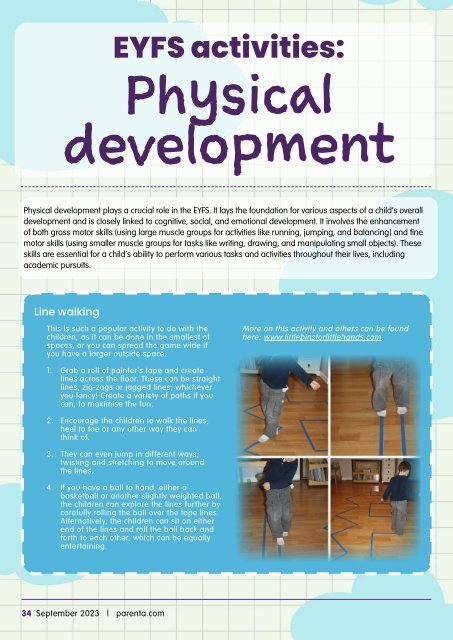September 2023 Parenta magazine
You also want an ePaper? Increase the reach of your titles
YUMPU automatically turns print PDFs into web optimized ePapers that Google loves.
EYFS activities:<br />
Physical<br />
development<br />
Physical development plays a crucial role in the EYFS. It lays the foundation for various aspects of a child’s overall<br />
development and is closely linked to cognitive, social, and emotional development. It involves the enhancement<br />
of both gross motor skills (using large muscle groups for activities like running, jumping, and balancing) and fine<br />
motor skills (using smaller muscle groups for tasks like writing, drawing, and manipulating small objects). These<br />
skills are essential for a child’s ability to perform various tasks and activities throughout their lives, including<br />
academic pursuits.<br />
Let’s balance!<br />
Turn your outdoor space into a balancing<br />
world! You can easily utilise a few basic<br />
materials, to create a wonderful balancing<br />
playground for the children.<br />
1. Place some flat rocks on the ground to form<br />
a line of stepping stones, and watch the<br />
little ones carefully balance as they step<br />
from one to another.<br />
2. If you know anyone cutting down a tree,<br />
you might be able to use a few pieces of<br />
the trunk for an extra level of fun. Dig them<br />
into the ground slightly by approximately<br />
an inch, using sand to level and settle<br />
them. They are great for balancing on and<br />
if you place them near each other, they are<br />
great for stepping from one to another.<br />
3. Alternatively, you can create a homemade<br />
playground balance beam. Simply get<br />
a plank of wood, with a couple of wider<br />
pieces screwed to the bottom at each end<br />
of the beam, to ensure stability when the<br />
children are balancing on it.<br />
Each of these simple balancing tools form a<br />
wonderful playground for young children, as<br />
they grow and develop their balancing skills.<br />
More on this activity and others can be found<br />
here: www.happyhooligans.ca.<br />
Line walking<br />
This is such a popular activity to do with the<br />
children, as it can be done in the smallest of<br />
spaces, or you can spread the game wide if<br />
you have a larger outside space.<br />
1. Grab a roll of painter’s tape and create<br />
lines across the floor. These can be straight<br />
lines, zig-zags or jagged lines; whichever<br />
you fancy! Create a variety of paths if you<br />
can, to maximise the fun.<br />
2. Encourage the children to walk the lines,<br />
heel to toe or any other way they can<br />
think of.<br />
3. They can even jump in different ways,<br />
twisting and stretching to move around<br />
the lines.<br />
4. If you have a ball to hand, either a<br />
basketball or another slightly weighted ball,<br />
the children can explore the lines further by<br />
carefully rolling the ball over the tape lines.<br />
Alternatively, the children can sit on either<br />
end of the lines and roll the ball back and<br />
forth to each other, which can be equally<br />
entertaining.<br />
More on this activity and others can be found<br />
here: www.littlebinsforlittlehands.com.<br />
On your marks!<br />
Build children’s small muscle strength by<br />
exploring mark-making with different tools on<br />
different surfaces and see where the learning<br />
journey leads you.<br />
1. Provide trays of sand, flour, powder paint,<br />
shaving foam and cornflour mix and a<br />
range of sticks, feathers, pieces of string,<br />
vehicles, toy animals, combs, and brushes<br />
with which children can make marks in<br />
the material. Additionally, give them some<br />
pipettes so they can make patterns in the<br />
dry material by squeezing water onto it. This<br />
will build up muscle strength in their fingers<br />
and help to prepare them for gripping<br />
traditional writing instruments.<br />
2. For an outdoor activity, set up a large tray<br />
outside with paper and provide sticks,<br />
mud, leaves, grass and flowers so that<br />
children can make marks using natural<br />
materials. You could also add bits of fruits<br />
and vegetables so that children can explore<br />
what happens when they crush these items<br />
or drag them across the paper.<br />
More on this activity and others can be<br />
found here: www.earlyyearseducator.co.uk.<br />
34 <strong>September</strong> <strong>2023</strong> | parenta.com
















